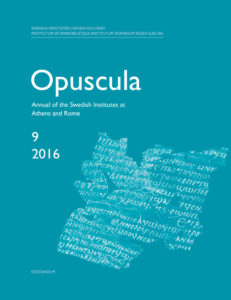 Opuscula is published by the Swedish Institutes at Athens and Rome, with the aid of a grant from the Swedish Research Council. Distributed by Eddy.se AB. View journal at ERIH PLUS. All content available with open access.
Opuscula is published by the Swedish Institutes at Athens and Rome, with the aid of a grant from the Swedish Research Council. Distributed by Eddy.se AB. View journal at ERIH PLUS. All content available with open access.
Excavations at the Monastery of St Antony at the Red Sea
By Jesper Blid, Fr Maximous El-Antony, Hugo Lundhaug, Jason Zaborowski, Meira Polliack, Mengistu Gobezie Worku & Samuel Rubenson
Abstract
This paper discusses the results from recent archaeological investigations at the Monastery of St Antony in Egypt, including the remains of a number of building phases predating the current church, locally produced pottery, and manuscript fragments written in Coptic, Arabic, Hebrew, and Ge’ez.
Introduction
St Antony is, according to tradition, the early 4th-century institutor of Christian monasticism, and his monastery, located some 30 km from the Red Sea coast and about 125 km south of Suez, is regarded as the oldest still-inhabited monastery. As for the chronology of the actual material formation of a monastery at the site, Antony must have settled here sometime before 337, if we are to believe the biography written by Athanasius of Alexandria shortly after his death. Several sources from the end of the 4th century mention the disciples of Antony staying at his desert retreat after his death in 356. Medieval sources refer to the monastery as built in the reign of Julian the Apostate, between 361 and 363. Ancient sources provide little information about the early monastery, and nothing that can be firmly associated with the standing structures within the precinct. The oldest extant remains are of a mural painting that was uncovered inside the Chapel of the Four Living Creatures (also called the Deesis Chapel) at the Church of St Antony during restoration work in the late 1990s. According to Elizabeth S. Bolman’s analysis, “the shortest span of years that we can posit for the early painting in the Church of St Antony is a 150-year period between c. 550 and 700”. Up until recently, however, no archaeological investigations had been conducted at the monastery, which makes the project presented in this article the first systematic excavation at the site. The study has, for instance, shed new light on the chronology, development, and economic networks of the monastery during the Middle Ages.
The excavations were conducted inside the Church of the Holy Apostles from 2004 to 2006 as part of larger restoration works at the church; both assignments were conducted under the direction of Fr Maximous el-Antony. The restoration and excavation were undertaken with the permission of the Egyptian Supreme Council of Antiquities and were funded by both the monastery and the American Research Center in Egypt. As a result of his previous work in late antique and Byzantine archaeology, Jesper Blid was invited by the monastery in 2014 to conduct find processing and to jointly prepare the publication of the excavations, as part of the project Early Monasticism and Classical Paideia of Lund University, which was financed by the Stiftelsen Riksbankens Jubileumsfond. The main authors of this study are Jesper Blid and Fr Maximous el-Antony; the additional authors are Hugo Lundhaug from the University of Oslo, Jason Zaborowski from Bradley University, Meira Polliack from Tel Aviv University, and Mengistu Gobezie Worku and Samuel Rubenson from Lund University.
Download PDF - Size: 2.97 MB - Downloads: 226 (since 2023)
Bibliographical information
Jesper Blid, Fr Maximous El-Antony, Hugo Lundhaug, Jason Zaborowski, Meira Polliack, Mengistu Gobezie Worku & Samuel Rubenson, ‘Excavations at the Monastery of St Antony at the Red Sea’, Opuscula. Annual of the Swedish Institutes at Athens and Rome (OpAthRom) 9, Stockholm 2016, 133–215. ISSN: 2000-0898. ISBN: 978-91-977798-8-3. https://doi.org/10.30549/opathrom-09-07

No Comments
Comments are closed.